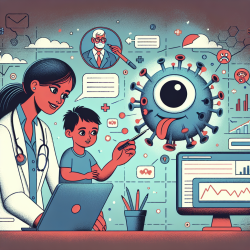Introduction
The intricate relationship between genetics and cognitive disorders has been a subject of extensive research. Two genes, FOXP1 and FOXP2, have been identified as significant contributors to cognitive and language development. This blog post delves into the findings from the research article "The distinct and overlapping phenotypic spectra of FOXP1 and FOXP2 in cognitive disorders" and explores how these insights can enhance the skills of practitioners in speech-language pathology.
Key Findings from the Research
The research highlights the distinct and overlapping roles of FOXP1 and FOXP2 in cognitive disorders. FOXP2 has long been associated with language development, particularly in cases of developmental verbal dyspraxia (DVD), a condition characterized by difficulties in coordinating the movements necessary for speech. FOXP1, on the other hand, has been implicated in a broader range of cognitive disorders, including intellectual disabilities and autism spectrum disorder (ASD), alongside language impairments.
Implications for Practitioners
Understanding the genetic underpinnings of language and cognitive disorders is crucial for practitioners aiming to provide targeted interventions. Here are some practical implications:
- Personalized Interventions: Recognizing the genetic factors involved can lead to more personalized therapy plans. For instance, children with FOXP2 disruptions may benefit from interventions focused on improving motor coordination for speech.
- Comprehensive Assessment: Given the broader cognitive implications of FOXP1 disruptions, practitioners should consider comprehensive assessments that evaluate both language and cognitive abilities.
- Interdisciplinary Collaboration: Collaborating with geneticists and neurologists can provide a more holistic understanding of the child's needs and lead to more effective treatment strategies.
Encouraging Further Research
The findings underscore the importance of continued research into the genetic basis of cognitive disorders. Practitioners are encouraged to stay informed about the latest developments in genetic research and consider participating in studies that explore the efficacy of different therapeutic approaches for children with genetic disruptions.
Conclusion
The insights from the research on FOXP1 and FOXP2 provide valuable guidance for practitioners in speech-language pathology. By integrating genetic information into their practice, practitioners can enhance the effectiveness of their interventions and contribute to better outcomes for children with cognitive and language disorders.
To read the original research paper, please follow this link: The distinct and overlapping phenotypic spectra of FOXP1 and FOXP2 in cognitive disorders.









